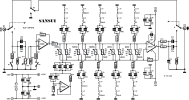Hello friends
The input level can be adjusted with P1, which may be necessary to adjust the balance between channels or when a volume control is used on the output amplifiers. A variety of op-amps can be used: in the original example, IC1 is an LT1007 and IC2 is an OP275. Other suitable variants for IC1 are OP27 or NE5534. And for IC2, AD712, LM833 and NE5532. If an NE5534 is used for IC1, C2 is required. In all other cases, no. The circuit must be powered by a regulated and symmetrical 15V power supply. Current consumption is 10 mA.
The professional equalizer presented in this article is suitable for use with hi-fi installations, professional systems. Mixer and electronic music instruments. Relay contacts in the inputs and outputs, in conjunction with S2, provide the possibility of selecting the desired channel. If desired, the input may be directly linked to the output. The input impedance and gain of the equalizer are adjusted by S1 and S3. The audio frequency spectrum of 31 Hz to 16 kHz is divided into ten bands. Ten bands need ten filters, nine bands are inactive and one is active. Passive filters are identical in design and differ only in the amount of inductors and capacitors involved. The necessary characteristics of filters are obtained by series and parallel networks.
The filter for the lowest frequency band is an active filter to avoid excessive value of inductance. This is the traditional way on the A1 opamp. The inductors used in passive filters are small chokes that are readily available. The filter based on L1 and L2 operates at approximately the lowest frequency (62 Hz) that can be achieved with standard, passive components. In principle, the Q factor (quality) of the filters can be slightly increased by increasing the value of R19 and R23, as well as P1-P10, but this will reduce the noise level of the opamp IC1. With the specified component values, the control range is about 11 dB, which would be very good.
The input level can be adjusted with P1, which may be necessary to adjust the balance between channels or when a volume control is used on the output amplifiers. A variety of op-amps can be used: in the original example, IC1 is an LT1007 and IC2 is an OP275. Other suitable variants for IC1 are OP27 or NE5534. And for IC2, AD712, LM833 and NE5532. If an NE5534 is used for IC1, C2 is required. In all other cases, no. The circuit must be powered by a regulated and symmetrical 15V power supply. Current consumption is 10 mA.
The professional equalizer presented in this article is suitable for use with hi-fi installations, professional systems. Mixer and electronic music instruments. Relay contacts in the inputs and outputs, in conjunction with S2, provide the possibility of selecting the desired channel. If desired, the input may be directly linked to the output. The input impedance and gain of the equalizer are adjusted by S1 and S3. The audio frequency spectrum of 31 Hz to 16 kHz is divided into ten bands. Ten bands need ten filters, nine bands are inactive and one is active. Passive filters are identical in design and differ only in the amount of inductors and capacitors involved. The necessary characteristics of filters are obtained by series and parallel networks.
The filter for the lowest frequency band is an active filter to avoid excessive value of inductance. This is the traditional way on the A1 opamp. The inductors used in passive filters are small chokes that are readily available. The filter based on L1 and L2 operates at approximately the lowest frequency (62 Hz) that can be achieved with standard, passive components. In principle, the Q factor (quality) of the filters can be slightly increased by increasing the value of R19 and R23, as well as P1-P10, but this will reduce the noise level of the opamp IC1. With the specified component values, the control range is about 11 dB, which would be very good.

